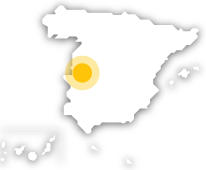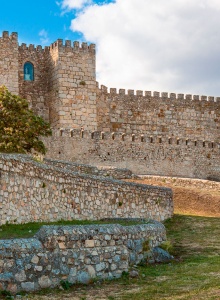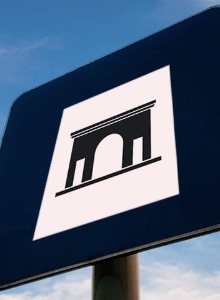Trujillo, located between the bottoms of the Tajo and Guadiana rivers, contains an important group of churches, castles and manor houses that are centred around the Plaza Mayor square and which are declared Property of Cultural Interest.
Also, this Cáceres city has left an important mark on history: since in the 16th century it was the cradle of illustrious characters linked to the discovery of America. For this reason, Trujillo falls fully within the Route of the Conquistadors, which includes other localities in Extremadura like Medellín, Villanueva de la Serena or Jerez de los Caballeros. Also, Monfragüe National Park, one of the most important protected spaces in Extremadura, spreads a few kilometres north of Trujillo and offers an extraordinary landscape of woods, meadows, and ponds.
The origins of Trujillo are found in the primitive settlement called Turgalium. After being occupied by Romans and Visigoths, Trujillo remained under Arabic dominion for over 500 years, during which time it underwent notable development. It then passed into Christian hands after being conquered in 1232 by King Fernando III, and it was monarch Juan II that gave Trujillo the title of city in 1430.In the 16th century, Trujillo experienced an age of great splendour due to its important role in the discovery of America. The city was the home of two great conquerors: Francisco de Pizarro, discoverer of Peru, and Francisco de Orellana. Other illustrious characters were also born in Trujillo, such as Fray Jerónimo de Loaísa, the first Bishop of Cartagena de Indias, and Nuflo de Chaves, discoverer of Bolivia. The city of Trujillo preserves its old flavour in its two areas: the medieval “village,” of Arabic origin, and the “city” from the 15th and 16th centuries.The cityThe city is structured around the monumental Plaza Mayor square, which is presided over by a bronze-cast statue of Pizarro on horseback. Over the centuries it has been the centre of social and commercial life of the city, hosting markets, festivals, and all kinds of shows. In the 16th century it became a noble plaza, since the conquistadors and diverse families from the nobility began to build houses and palaces in it.Around the square, the San Francisco (1600), Santa Clara (late 15th century) and San Martín Churches rise up, the last of which was built between the 14th and 16th centuries. The temple, of only one nave and vault, houses various Renaissance side chapels. Also, there are many palaces and manor houses (16th-18th centuries) that are characterized by their angular balconies, an element distinct to the civil architecture of Trujillo.The Palace of the Dukes of San Carlos (16th century), for example, has this typical angular balcony and the coat of arms of the Vargas-Carvajal family. Behind the main façade an interior patio is hidden, built in classical style and with a rectangular floor, with two levels and porticos with Tuscan columns.The Palace of the Marquis of Piedras Albas is another notable building among those that face the plaza. This Renaissance mansion, work of Pedro Suárez de Toledo, has so-called “bread” colonnades and is notable for its three segmented arches.One of the most outstanding in the area is the Palace of the Marquises of the Conquista or of the Coat of Arms. Its construction, in 1570, was financed by Hernando Pizarro. On its façade is a corner balcony with Plateresque decorations and two alabaster columns. It is topped by the coat of arms of Francisco Pizarro.On the cobblestone streets that leave from the plaza there are other notable residences such as the House of the Royal Peso or of the Chaves Cárdenas, Gothic with Renaissance additions, or the Palace of Juan Pizarro of Orellana, from the 16th century. The latter belonged to the first ruler of the Peruvian city of Cuzco and was transformed into a Renaissance palace after being the stronghold of Diego de Vargas. Inside the building is a patio built in the Plateresque style.Meanwhile, the Citadel of the Altamiranos or Alcazarejo was erected by Fernán Ruiz starting in the 13th century. The main gate stands out, from the 16th century, flanked by two crumbling towers with the coat of arms of the Altamiranos.Religious architectureThe “village” is enclosed by a wall marked by 17 towers, the remains of the Citadel of the Bejarano and the Jerónimas lookout. On one end is the Arabian Caliphate Castle (mid-9th century, expanded in the 12th century), in the centre, churches such as Santa María la Mayor (13th to 16th century), Santiago (13th to 17th century) and Vera Cruz (13th century), and manor houses such as the fortresses of Luis Chaves “el Viejo” (14th-15th century) and of the Altamiranos (16th century).The Santa María Temple is considered to be one of the most beautiful examples of the Romanesque style in Trujillo. The building, constructed atop an old mosque, has many medieval portals on the outside and a tower from the late Romanesque period. Inside, the vaults that cover the structure of three naves can be admired, as well as an outstanding Gothic altarpiece made by Fernando Gallego in 1480 and which is considered to be one of the best in Extremadura.The Santiago Church, located next to the gate of the city of the same name, was built in the 13th century and later remodelled between the 15th and 17th centuries. A semi-cylindrical apse and the tower are left over from the original construction. The church guards the image of Nuestra Señora de la Coronada, Romanesque style, and that of the Cristo de las Aguas, from the 14th century.The Arabian Caliphate Castle rises dominant over the city, built during the age of greatest splendour of the Caliphate of Córdoba. This building stands out because of its beautiful flanking towers and the two reservoirs found in the inner ward. In the south part of the bastion the Virgen de la Victoria Shrine rises up, the patron saint of the city.To finish the tour of the city, there is nothing better than going to the Coria Museum, which occupies what used to be the San Francisco el Real Convent. The premises allow one to draw near to the most important milestones in the discovery of the New World.And if desired, you can visit Trujillo to enjoy one of the most important festivals, the traditional Chíviri. This celebration, which takes place each Easter Sunday in the Plaza Mayor square, has been declared a Festival of Tourist Interest. Gastronomy and the surroundingsTrujillo shares the most representative dishes of the region with the rest of Extremadura. Products derived from Iberian pig are outstanding, as well as recipes of pastoral origin: caldereta (a stew prepared with sheep or goats meat), migas (with a bread base), etc. Also asparagus soup, lima bean soup, or traditional cold soups such as gazpacho and ajoblanco cannot be forgotten.Some types of produce are typical of the food of Trujillo, such as chard or wild asparagus and truffles. Among the most well known deserts are toasted cream and candied stuffed eggs. All of these dishes should be paired with the excellent wines with the Denomination of Origen Ribera del Guadiana. Many of these traditional recipes can be enjoyed in the Parador de Trujillo, located in the old Santa Cruz monastery. It is a 16th century convent with two beautiful cloisters, one in the Renaissance style.Trujillo is the first stop on the Ruta de los Conquistadores, known by this name because it passes through the birthplaces of many illustrious characters tied to the discovery of America. This route enters the province of Badajoz and passes through Medellín, Villanueva de la Serena, Badajoz and, finally, through Jerez de los Caballeros.Woods, rock outcroppings and meadows irrigated by rivers, ponds and reservoirs spread a few kilometres to the north of Trujillo creating the Monfragüe National Park. Other nearby enclaves for enjoying the natural landscape of Cáceres are Montánchez, a small locality on the mountain of the same name, and Alhuéscar, nestled among oak trees.








